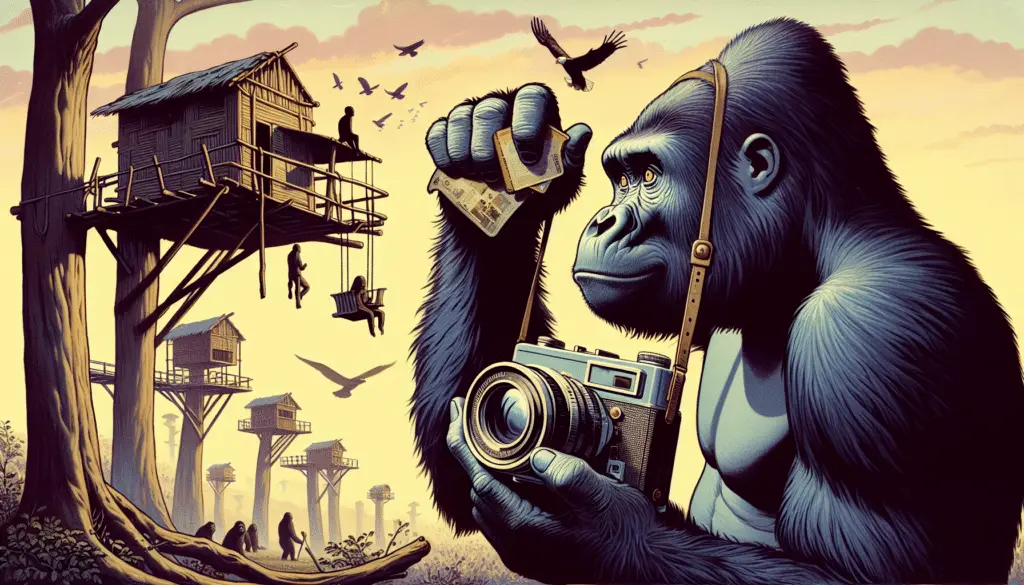Gorillas and Human Interaction: An Overview
Table of Contents
ToggleUnderstanding how gorillas interact with humans is essential for conservation efforts and ensuring the well-being of these remarkable primates.
Gorillas are shy and generally avoid humans. However, interactions can vary based on the context and environment.
In the wild, gorillas rarely initiate contact with humans. They prefer living away from human settlements and are more comfortable in their natural habitats.
Human activities such as logging, agriculture, and urban development often encroach on gorilla territories, leading to more frequent encounters.
Tourism has also created scenarios where gorillas become habituated to human presence. This is often seen in gorilla trekking activities in places like Rwanda, Uganda, and Congo.
While habituated gorillas may tolerate human photographers and researchers, it’s vital to maintain a respectful distance to avoid stress or potential aggression.
Gorilla Trekking: A Popular Human-Gorilla Interaction
Gorilla trekking is a significant part of ecotourism in regions like Rwanda’s Volcanoes National Park and Uganda’s Bwindi Impenetrable National Park.
These treks offer a chance for humans to observe gorillas in their natural environment, contributing to local economies and funding conservation efforts.
When planning a gorilla trek, it’s essential to follow guidelines set by park authorities to minimize disruption to gorilla groups.
Staying at least seven meters away from gorillas is crucial to avoid transmitting diseases and causing stress to the animals.
Despite the benefits, gorilla trekking must be conducted responsibly to ensure long-term sustainability for both humans and gorillas.
Human Influence on Gorilla Behavior
Continuous exposure to humans can alter gorilla behavior. Habituated gorillas become accustomed to human presence, which can reduce their natural fear of potential threats.
This habituation can lead to increased vulnerability to poaching and disease. Ensuring strict regulations and monitoring can help mitigate these risks.
Gorillas in Captivity
Gorillas in zoos and sanctuaries present another form of human interaction. These environments offer controlled conditions for research, breeding, and education.
Zoos like the San Diego Zoo and the Bronx Zoo have successful gorilla conservation programs, helping to raise public awareness and support for wild populations.
Interactions in captivity are carefully managed to ensure the physical and psychological well-being of gorillas.
Research conducted in zoos contributes invaluable insights into gorilla behavior, genetics, and health, which are critical for species conservation.
Challenges and Conservation Efforts
Human-gorilla interactions are not without challenges. The primary threats include habitat destruction, poaching, and disease transmission.
Conservation efforts aim to protect natural habitats, enforce anti-poaching laws, and promote sustainable tourism.
Organizations like the Dian Fossey Gorilla Fund and the Gorilla Doctors play a crucial role in these initiatives, providing resources and expertise to safeguard gorilla populations.
Local communities are also involved in conservation, with education and economic incentives helping to reduce human-wildlife conflict.
Products to Enhance Gorilla Conservation
Supporting gorilla conservation can be as simple as choosing the right products. Eco-friendly products and companies that invest in conservation initiatives make a difference.
One example is the Gorilla Conservation Coffee, which donates a portion of proceeds to gorilla conservation projects. This coffee is grown in regions near gorilla habitats, providing economic benefits to local communities and reducing the need for habitat destruction.
Rating and Recommendations
- Gorilla Conservation Coffee is well-reviewed for its quality and conservation impact.
- People appreciate that it’s a way to enjoy a great cup of coffee while supporting gorilla preservation.
- Buying from ethical and eco-friendly brands helps protect gorilla habitats indirectly.
Find This and More on Amazon
Gorilla-Human Interaction in Research
Research on gorillas often involves close human interactions. Field studies and laboratory research provide insights into gorilla behavior, health, and genetics.
Researchers use non-invasive techniques to study gorillas, prioritizing their safety and well-being.
Technological advancements, such as camera traps and drones, allow for monitoring gorillas without direct human presence.
Collaboration with local communities and authorities is essential to ensure ethical and effective research practices.
Frequently Asked Questions:
Q: Are gorillas dangerous to humans?
Gorillas are generally shy and non-aggressive towards humans. However, provocation or perceived threats can lead to defensive behavior.
Q: How close can you get to a gorilla?
Maintaining a distance of at least seven meters from gorillas is recommended to avoid stressing them and reducing the risk of disease transmission.
Q: Can gorillas interact with humans peacefully?
Yes, particularly habituated gorillas can interact peacefully with humans, especially during controlled tourism activities.
Q: What kind of diseases can gorillas contract from humans?
Gorillas are susceptible to many of the same diseases as humans, including respiratory infections, Ebola, and COVID-19.
Q: How can we help protect gorillas?
Supporting conservation organizations, choosing eco-friendly products, and promoting sustainable tourism are practical ways to help protect gorillas.
Q: Why is it important to protect gorillas?
Gorillas play a critical role in their ecosystems by dispersing seeds and maintaining forest health. They are also a significant part of our natural heritage.
Q: Are there any international efforts to save gorillas?
Yes, organizations like the International Union for Conservation of Nature (IUCN) and the World Wildlife Fund (WWF) are actively involved in gorilla conservation.
Learn more about Western Lowland Gorillas
Gorilla-Human Interaction in Local Communities
In regions close to gorilla habitats, local communities often come into direct contact with these primates.
Proximity to gorilla populations can sometimes lead to conflicts, especially when gorillas raid crops or enter villages in search of food.
Community-based conservation initiatives work towards mitigating these conflicts by educating locals on the importance of gorilla conservation and providing alternative livelihoods.
For example, some programs offer training in sustainable agricultural practices that are less likely to attract gorillas.
Gorillas and Ecotourism: Benefits and Responsibilities
Ecotourism can provide significant benefits for gorilla conservation, but it also comes with responsibilities.
Revenue generated from permits and tourism activities often goes directly into funding conservation projects and local community development.
However, tourism must be managed carefully to ensure it does not negatively impact the gorillas.
Strict guidelines and regulations help ensure that interactions are safe and beneficial for both gorillas and humans.
Understanding Gorilla Behavior During Human Interaction
Gorillas exhibit specific behaviors when they encounter humans, which can help us understand their comfort levels and reactions.
Calm, habituated gorillas often engage in curious glances and may continue their activities without much interruption.
However, signs of stress or aggression, such as chest-beating or vocal alarms, indicate that gorillas feel threatened.
Recognizing these behaviors is crucial for ensuring that human presence does not cause undue stress or provoke defensive actions.
Products Supporting Gorilla Research and Conservation
Several products support gorilla research and conservation, allowing individuals to contribute to these efforts through their purchases.
The WWF Gorilla Adoption Kit is one such example, which includes a plush toy, a certificate, and information about gorilla conservation.
Rating and Recommendations
- The WWF Gorilla Adoption Kit is highly rated for its educational value and contribution to conservation efforts.
- Customers appreciate that their purchase directly supports WWF’s work in protecting gorilla habitats and populations.
- The kit serves as a thoughtful gift that raises awareness about wildlife conservation.
Find This and More on Amazon
Technological Innovations in Gorilla Monitoring
Modern technology has significantly enhanced the monitoring and study of gorillas, providing new insights into their behavior and health.
Camera traps equipped with motion sensors capture images and videos of gorillas in their natural habitat without disturbing them.
Drones offer aerial views and help researchers track gorilla movements across large areas.
These innovations allow for more accurate data collection and better-informed conservation strategies.
Gorillas and Human Education Programs
Education programs play a vital role in fostering positive human-gorilla interactions and ensuring the survival of gorillas.
Schools and community centers near gorilla habitats often run initiatives to teach children and adults about the importance of gorillas.
These programs highlight the role gorillas play in the ecosystem and the need for their protection.
Educational outreach helps build a generation of conservation-minded individuals who can support and sustain gorilla conservation efforts.
Frequently Asked Questions:
Q: How do gorillas react to humans in their habitat?
Gorillas usually react cautiously and avoid humans, although habituated groups may display curiosity and tolerance.
Q: What is the impact of human activity on gorilla habitats?
Human activities like logging, agriculture, and urban development lead to habitat loss and fragmentation, putting gorillas at risk.
Q: How can ecotourism harm gorillas?
Poorly managed ecotourism can stress gorillas, disrupt their natural behaviors, and increase the risk of disease transmission.
Q: Do captive gorillas interact differently with humans compared to wild gorillas?
Yes, captive gorillas are more accustomed to human presence and may show different behaviors than those in the wild.
Q: How does technology help in gorilla conservation?
Technologies like camera traps and drones help monitor gorillas without direct human intervention, providing valuable data for conservation.
Q: Can local communities benefit from gorilla conservation?
Yes, conservation efforts can create jobs, improve infrastructure, and provide education, benefiting local communities economically and socially.



